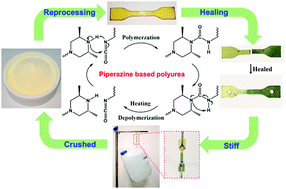Reducing the reprocessing and healing temperature of polyurea with piperazine-based hindered urea bonds†
Abstract
Stiff polymers exhibiting good reprocessing and self-healing ability under a moderate stimulus are often desirable for many special applications, but are also full of challenges, which comes from how to achieve a balance between dynamic reversibility and high stiffness. Herein, we describe a stiff polyurea bearing piperazine-based dynamic hindered urea bonds which can be reprocessed and healed under mild conditions. This material holds a high mechanical strength (flexural modulus of 3340 MPa and tensile modulus of 1006 MPa), while it can be reprocessed at 70 °C and 300 kPa, and healed at 70 °C in 60 min with almost 100% healing efficiency. Such superior performances can be rationalized by the small energy barrier (6.86 kcal mol−1) for bond exchange and high kinetics speed constant (0.90 h−1) of reverse reaction, as revealed by thermodynamic and kinetic studies. The decrease in energy barrier for bond exchange and increase of kinetics speed constant are attributed to the high reactivity and large steric hindrance of piperazine groups. The stiff, reprocessable and healable polyurea obtained in this work would be attractive for sustainable industrial applications.



 Please wait while we load your content...
Please wait while we load your content...